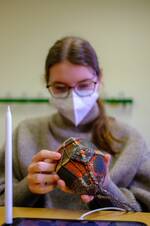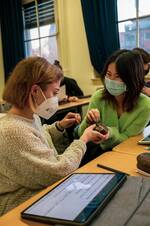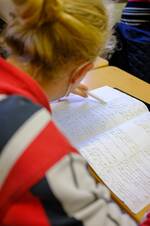- Home
- Aktuelles
- Ansprechpartner
- Ganztag
- Schulprofil
- Schulleben
- IServ
TOK - Theory of Knowledge
What we do
In TOK you will learn about different ways of thinking and knowledge. You will learn what they are and how they are different from each other. To do so, you will consider various aspects such as: different perspectives, ethnics, languages, cultures etc. We also question simple things people would not doubt at first glance. We do this in order to get a deeper insight into different things in various ways. To make things easier, take a look at the sample lesson.
Example lesson
In the pictures you can see a part of our lesson. As you can see we use creative ways to engage with topics. If you enjoy speaking and communicating, TOK will be the perfect choice for you. You will get to speak and to interact with people a lot. If you are rather on the shyer side, it’s perfectly fine. You are not forced to share things if you do not want to. If writing is more enjoyable for you, you can be assured that you do need to write texts quite often. So if you rather enjoy writing creative texts this will be great opportunity for you. Throughout the course you will be required to compile an exposition. Three objects will be chosen by you and described in great detail. Do not worry about anything yet as your teachers will give you a lot of help and be by your side throughout the whole process.

Pictures
In the first two pictures you can see the so-called promise stone.
The stone is from the indigenous people of the highlands of Papua New Guinea, which is north of Australia.
You need to know that their religion was not written down in books. Whenever they had conflicts within the tribe or with other tribes they would swear to tell the truth while putting their fingers on the stone. Although, every stone is unique with its own combination of patterns and colors they all contain the same meaning.

The promise stone is a window through which the TOK course better helps students explain concepts of imagination, power, perspective and responsibility. What may be viewed as a piece of interesting art to a western audience clearly has a more rounded and deeper significance to the peoples from whence it came.

The third picture shows an interview from 1811 conducted by Captain Sam Warner with Jonathan Lambert, the first settler on the island of Tristan da Cunha, an island located in the South Atlantic Ocean. Mr Lambert had the idea to use the island as a midway resting station where sailors could replenish their supplies of fresh water, meat and vegetables. He was even prepared to go as so far as to rename the island “the Isle of Refreshment”.
This unique account of island life in the early 19th century is used in TOK lessons to grapple with questions such as … What counts as good evidence of a claim? What challenges are raised by the dissemination and/or communication of knowledge?